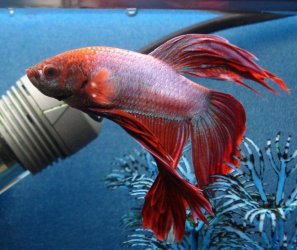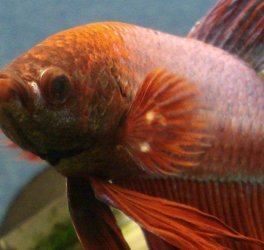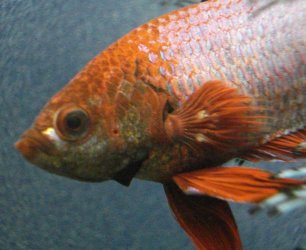I'm really stuck on this one!
My male fighter has lived happily for several months with no problems, but over a week ago started to develop white lumps on his fins. He doesn't have these anywhere else, although he has also turned from mainly flame red to red and green over the last couple of weeks as well. He seems a little lethargic, sometimes resting on the bottom (which rings alarm bells for me as he very rarely used to do this).
He is in a 25 litre tank, filtered, aerated and heated (27C) and lives with Tetras (Blue neon, cardinal, black neon and rummy noses), lamp eyes and a couple of tiny Ottos.
The tank has been set up and stable for about 6 months. The most recently added fish were the 2 Ottos about 6 weeks ago to clean algae from my plants.
There has only been one death in the tank in the last 3 months or so, which was a blue neon about a week ago (unknown cause, no sign of disease, so presumed old age).
We do a 30% water change every 2 - 3 weeks (heated to temperature and de-chlorinated) and the filter is cleaned (using tank water) once in between the water changes (never at the same time).
Recent water tests were near perfect (Ammonia, Nitrite, Nitrate) although if you feel it would help I can do another water test and provide exact figures.
I'm attaching photos... they are slightly blurry but should still show the problem better than I can describe it!
I started a course of Protozin 3 days ago, thinking it may be whitespot... but the more I look at him, the more I just don't think it looks like any whitespot I have ever seen!
Please help... I already lost my favourite fighter (unknown causes) about a week ago in another tank after having him about 8 months, would hate to lose this guy as well!
Thanks!
Kee
My male fighter has lived happily for several months with no problems, but over a week ago started to develop white lumps on his fins. He doesn't have these anywhere else, although he has also turned from mainly flame red to red and green over the last couple of weeks as well. He seems a little lethargic, sometimes resting on the bottom (which rings alarm bells for me as he very rarely used to do this).
He is in a 25 litre tank, filtered, aerated and heated (27C) and lives with Tetras (Blue neon, cardinal, black neon and rummy noses), lamp eyes and a couple of tiny Ottos.
The tank has been set up and stable for about 6 months. The most recently added fish were the 2 Ottos about 6 weeks ago to clean algae from my plants.
There has only been one death in the tank in the last 3 months or so, which was a blue neon about a week ago (unknown cause, no sign of disease, so presumed old age).
We do a 30% water change every 2 - 3 weeks (heated to temperature and de-chlorinated) and the filter is cleaned (using tank water) once in between the water changes (never at the same time).
Recent water tests were near perfect (Ammonia, Nitrite, Nitrate) although if you feel it would help I can do another water test and provide exact figures.
I'm attaching photos... they are slightly blurry but should still show the problem better than I can describe it!
I started a course of Protozin 3 days ago, thinking it may be whitespot... but the more I look at him, the more I just don't think it looks like any whitespot I have ever seen!
Please help... I already lost my favourite fighter (unknown causes) about a week ago in another tank after having him about 8 months, would hate to lose this guy as well!
Thanks!
Kee



 /www.jbl.de/onlinehospitaluk/perpict...lickedPic=024_b
/www.jbl.de/onlinehospitaluk/perpict...lickedPic=024_b


